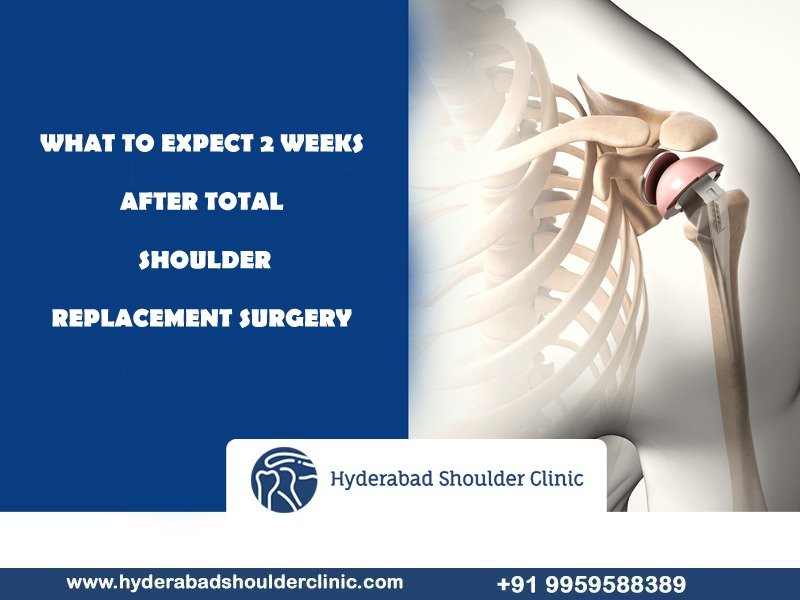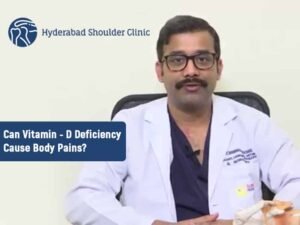Anyone undergoing shoulder replacement surgery should know all about the postsurgical recovery process. Knowing what happens post-surgery will help you plan your work, make any adjustments at home, and, more importantly, you are prepared mentally for the postsurgical period.
Immediately after the surgery, we at Hyderabad Shoulder Clinic will move you into the recovery room, where you’ll stay for a couple of hours. You are here till you wake from anaesthesia and are ready to be taken to your hospital room. You will feel numbness on the operated arm from the nerve block, which can provide effective pain relief, and you won’t be able to move your fingers or wrist on the operated arm.
For six weeks, you’ll use a shoulder sling or brace. This protects the replaced joint and the rotator cuff. The sling or brace shoulde be worn 24×7 for first two weeks. After 2 weeks should be worn in public or while moving around or during sleep, but you can loosen it while reading, watching television, or working at a desk. After the surgeon’s approval, you can perform routine activities, such as eating, writing, or shaving with the operated arm. Avoid lifting objects or making sudden moves, such as quickly reaching for something, until you’re instructed that it’s safe to do so.
Total shoulder replacement is a very successful operation, and in 90% of cases, the implants are free of complications even ten years after surgery. Most patients live with well-functioning shoulders and return to their daily living and low-impact sports without pain. Of course, one must be prepared for any rare occurrence of surgical complications, such as infection or bleeding or peri prosthetic fracture or dislocation. However, if the patient does not wear the sling for the recommended period, the replacement shoulder is likely to dislocate.
What happens two weeks after shoulder replacement surgery?
For a healthy recovery from shoulder replacement surgery, rehabilitation is essential. This is true for partial shoulder replacement, an anatomic total shoulder replacement, or a reverse total shoulder replacement. If surgery is one part of the equation, physical therapy is the other side for complete recovery from shoulder ailments. Immediately after the surgery, the focus is on soft tissue healing and bone growth into the implant.
Recovery Timeline immediately after the surgery
Though the general timeline varies from individual to individual, below is a general timeline that one can expect:
- Days 1-4: Reduction in pain and swelling
- Weeks 0-2: No shoulder movements or exercises, but u can actively mobilise wrist and elbow, Dressing on post operative day 1, and week 1, Suturr removal on week 2
- Weeks 2-6: By maintaining the sling, one can do some light activities, like lifting a cup of coffee or making a sandwich
Physical therapy
- Therapy begins with small movements of the hand, wrist, and elbow that focus on a range of motion. On the first day after surgery, a physical therapist will teach you specific exercises to prevent your elbow and wrist from getting stiff and help you regain your entire range of motion. Starting with “passive” exercises in which you or the therapist moves your arm for you, you will move on to more active movements like shoulder shrugs, elbow raises, and weights. Performing the exercises will be difficult initially but will get easier over time. Before you leave the hospital, a physical therapist will ensure you do them correctly.
- Patients with an anatomic shoulder replacement will start a structured physical therapy program focusing on passive range-of-motion exercises one to two weeks post-surgery.
- If the surgery was for reverse shoulder replacement, patients must wait for six weeks to start with physical therapy. After six weeks, they can start tapering the use of the sling. Their physical exercises will be focussed chiefly on regaining active motion.
- Only after three months can patients do shoulder strengthening exercises.
- After six months, they can return to most activities that involve the shoulder.
Exercise may cause swelling and bruising of your hand and arm. To relieve these symptoms, one has to bend and straighten the elbow frequently and periodically make a fist to boost circulation.
At home care
The patient is usually discharged from the hospital the day after surgery. The patient is discharged after being medically stable, and the pain is controlled. During the first few weeks, follow your orthopaedic surgeon’s instructions carefully.
Medications
Mostly, you will receive prescriptions for a few types of pain medication. We at Hyderabad Shoulder Clinic will clearly explain the timing and dosing of your medications before you leave the hospital.
Caring for the surgical site
There will be stitches along your incision, and they will be removed at your first follow-up appointment, one to two weeks post-op. But if your incision swells, drains, turns red, or becomes painful, or if you develop a temperature over 101°F, call your surgeon immediately.
Ensure that the dressing or bandage covering your incision does not get wet or dirty; moisture increases the risk of infection. Just leave the dressing alone until your first post-op appointment. Only after the stitches are removed and with an OK from your doctor can you take a shower. Still, avoid submerging the area in a bathtub or swimming pool until the incision has completely healed. Make sure you dry the wound site properly after the shower.
Follow-up appointments
The general guidelines are that follow-ups are scheduled one to two weeks after surgery and six weeks after surgery. In the first appointment, the stitches and an X-ray of your shoulder will be removed.
Within the first year, you’ll see your orthopaedic surgeon for routine follow-up visits at three months, six months, and 12 months. Sometimes, an annual visit is also suggested to assess the status and functionality of your implant.
As a final note, please understand that the shoulder replacement rehab timeline is different for everyone. As a 40-year-old with a physical job, everyone has a different routine than an elderly man who’s retired. Dr.Chandra Sekhar B says that before the surgery, one of the best things to remember for the recovery process is that it will take time and patience. At the Hyderabad Shoulder Clinic, we tell all our patients that shoulder replacement is a slower process and that adhering to postoperative instructions leads to excellent pain relief and function. For more information, please visit our website https://hyderabadshoulderclinic.com/ or contact us at +91 9959588389 or shoulderandsportsclinic@gmail.com.





